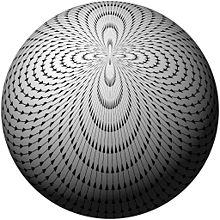There is a short conceptual proof of Gauß-Bonnet due to Chern (see also "A panoramic view of Riemannian geometry" by Berger). The argument assumes a basic familiarity with differential forms though.
Assume that the surface $S$ is oriented so that its canonical measure $dm$ is a 2-form. Let's consider the set of all unit vectors tangent to $S$, i.e. the unitary fiber $US$ of $S$. The canonical projection $p:US\to S$ associates with each unit vector a point on $S$ where it is tangent. Now, $US$ is a 3-manifold which posesses a canonical differential form $\zeta$. The exterior derivative $d\zeta$ is the form lifted by $p$ onto $US$ of the 2-form of the curvature $K(m)dm$. If the domain $D\subset S$ is simply connected, one can define a continuous field $\xi$ of unit vectors on $D$; therefore, $D$ can be lifted into $US$.
The Gauß-Bonnet formula follows directly from the Stokes formula applied to $\xi(D)$ since the canonical 1-form $\zeta$ is the geodesic curvature. This is actually more than you ask for because the boundary of $D$ does not have to consist of geodesics.
I have a number of results on hard disks in various types of regions, and preprints are in progress. The terminology "hard spheres" (or "hard disks" in dimension 2) comes from statistical mechanics, and I believe Fred Cohen is following my lead on this. (See for example the hard disks section of Persi Diaconis' survey article.)
--- With Gunnar Carlsson and Jackson Gorham, we did numerical experiments and computed the number of path components for 5 disks in a box, as the radius varies over all possible values. This is quite a complicated story already, as the number is not monotone or even unimodal in the radius. (This preprint is almost done, a rough copy is available on request.)
--- With Yuliy Baryshnikov and Peter Bubenik we develop a general Morse-theoretic framework and proved that in a square, if $r < 1/2n$ then the configuration space of $n$ disks of radius $r$ is homotopy equivalent to $n$ points in the plane. On the other hand this is tight: if $r> 1/2n$ then the natural inclusion map is not a homotopy equivalence. (Again this preprint is getting close to be being posted to the arXiv...) There is a much more general statement here.
--- I also have some results with Bob MacPherson about hard disks in a square and also in (the easier case of) an infinite strip. We have been talking to Fred Cohen about this a bit lately, who believes there may be connections to more classical configuration spaces.
I am slightly self-conscious about claiming results here, without first having posted the preprints to the arXiv, but I just wanted to state that there are a number of things known now, and I am working hard to get everything written up in a timely fashion. In the meantime I have some slides up from a talk I recently gave at UPenn.
Here is a concrete example, since that might be more satisfying.
It turns out for $3$ disks in a unit square:
For $0.25433 < r$, the configuration space is empty,
for $0.25000 < r < 0.25433$ it is homotopy equivalent to $24$ points,
for $ 0.20711 < r < 0.25000$ it is homotopy equivalent to $2$ circles,
for $ 0.16667 < r < 0.20711 $ it is homotopy equivalent to a wedge of $13$ circles, and
for $ r < 0.16667$ it is homotopy equivalent to the configuration space of $3$ points in the plane.
For $4$ disks in a square it looks like the topology changes $9$ or $10$ times, and for $5$ disks it looks like the topology might change $25$-$30$ times or more. The general idea is that certain types of "jammed" configurations act like critical points of a Morse function, and mark the only places where the topology can chance.
Update: two preprints have been posted to the arXiv.
Min-type Morse theory for configuration spaces of hard spheres (Baryshnikov, Bubenik, Kahle):
http://arxiv.org/abs/1108.3061
Computational topology for configuration spaces of hard disks ( Carlsson, Gorham, Kahle, and Mason):
http://arxiv.org/abs/1108.5719
Update (January 2022): A lot has happened in the past year or two. Here are some more preprints that have been recently posted to the arXiv.
Configuration spaces of disks in an infinite strip (Alpert, Kahle, MacPherson)
https://arxiv.org/abs/1908.04241
Configuration spaces of disks in a strip, twisted algebras, persistence, and other stories
(Alpert and Manin)
https://arxiv.org/abs/2107.04574
Homology of configuration spaces of hard squares in a rectangle (Alpert, Bauer, Kahle, MacPherson, Spendlove)
https://arxiv.org/abs/2010.14480

Best Answer
One of the standard generalizations is Knaster's conjecture: for every function $f: \mathbb{S}^{n-1}\rightarrow \mathbb{R}^m, m\lt n,$ and $k=n-m+1$ points $p_1, \dots, p_k \in \mathbb{S}^{n-1}$ does there always exista rotation $\rho \in SO(n),$ such that $f(\rho(p_1) = \dots = f(\rho(p_k)).$ That this is true for $k=2$ is a theorem of H. Hopf (which generalizes Borsuk-Ulam). It turns out that Knaster's conjecture is true for some $m, n$ and false for others. See this nice paper by Hinrich and Richter for more results and references.